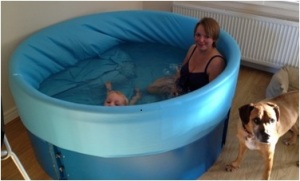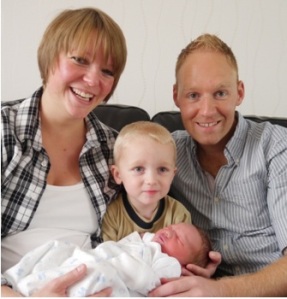Hypnobirthing has changed practice in birthing suites and will continue to do so. There are many good things that have happened over the years, and all the time I am aware of improvements as we edge towards a more natural and woman-centred regime, but nothing has made the practical difference that Hypnobirthing has. It is very important that everyone is aware of and fully conversant with what is going on.
As yet there is little research on Hypnobirthing, though various studies point to the profound effect it has. I hope this document will help you understand more about it.
The principle behind hypnobirthing is the fear-tension-pain premise put forward by Grantley Dick Read. In our society, everyone ‘knows‘ that birth is painful so, however much a woman is looking forward to having a baby, which she undoubtedly is, that is the background in which she has grown up. As long as that background is in place, she is unlikely, after she has had her baby, describe it as ‘the most wonderful and empowering experience of her life‘ which is what I frequently hear from hypnobirthing mothers.
We all know the procedures that go on with heart-breaking regularity in delivery suites. It is wonderful that these medical procedures are available when needed, but we can’t help asking if they are needed as much as they are used today. Hypnobirthing educates a mother, and equips her to deal with whatever turn her labour may take. It cannot promise the perfect birth; nothing could – that would be unrealistic. But it is amazing how often this is achieved. Whatever the outcome, hypnobirthing makes a difference, and a very big difference too. Hypnobirthing gives you the tools to have the best birth for you.
A hypnobirthing course is a full antenatal training. It is based on knowledge, profound and simple logic, and information. There is nothing new in birth, after all it has been around for a very long time, but hypnobirthing looks at the facts in a completely different way which makes a dramatic difference. Midwives who are present at a hypnobirthing birth for the first time are amazed at the calmness of the mother and I often hear the exlamation, ‘I’ve never seen anything like it. I couldn’t believe how calm she was.‘
A hypnobirthing course lasts for about 12 hours, either 4 or 5 evenings or 2 days, and ideally a couple do the hypnobirthing course together. They learn:
- What hypnosis is
- What hypnobirthing is
- How the muscles of the uterus and the hormones work in a way which throws an entirely new light on this system
- The power of the mind (greatly under-estimated by most people)
- The physical aspects of birth, e.g.pelvic floor exercise, perineal massage, positions, back to back babies, breech babies.
- Breathing and visualisations that work with the body
- Relaxations to practice together
- How to apply what they have learnt when they give birth
- Common procedures in delivery suites
- How to get all the information they need in order to choose the best course for them
- How to release fear
You are also given The Hypnobirthing Book, and the Colour and Calmness Relaxation CD to play each night as you go to sleep to release fears and build a positive view of birth. This will affect the hormones you produce, which will also affect your baby, and the efficiency and comfort with which you give birth. You are also given a folder of handouts to continue your practice at home.
People come to a hypnobirthing course expecting to receive a lot of techniques to raise their pain threshold, take them to some spaced-out state so they don’t notice the pain, or not notice as the pain washes over them. Yes, we give them breathing, visualisation and relaxation techniques, but these have been around for years, so what makes hypnobirthing so different, and so effective? There are three things:
- The work to release fear, so that a woman looks forward to her birth with positivity and optimism.
- She learns to relax very deeply; much deeper than a short relaxation at the end of an antenatal class.
- Rather than just being told to go away and practice, she is given a simple programme that she can use to continue the work at home. All the best birth reports that I have received have also said, ‘And I practised lots.‘
Learning hypnobirthing is completely different from preparing for any other important event in our lives. If we are preparing for an exam, we add more and more information, we do a trial run, and the night before we really cram it in, and then we produce it on the day.
Hypnobirthing does exactly the opposite. With each practice a woman learns to let go, and let go, of her fears, her preconceptions, so that by the time she gives birth that perfect system that is already in place in her body and mind can shine forth and work as it is designed to do, comfortably and efficiently. It is difficult to explain. It is something you experience.
I have written The Hypnobirthing Book which fully explains hypnobirthing. Since hypnobirthing is having such a profound effect, it is important that all women consider how it can support them in giving birth.
Here is a mother’s description of hypnobirthing:
In late December, my husband and I attended – with a considerable degree of scepticism – your Hypnobirthing course. We had absolutely no idea what to expect and were worried it would be a bit hippie for our liking. In fact, it changed our lives forever and I wanted to say a huge thank you for the epiphany you inspired in us.
On Sunday, March 2nd we welcomed to the world little Felix, who arrived at 7:04pm weighing 8lb 1oz. Felix is heavenly and we are, predictably, crazy in love. But much more significantly – just a few months ago, I was one of those ridiculously well-educated but utterly-clueless-about-birth 21st-century, 30-something professional women who assumed I would march into hospital demanding an epidural and every single drug going. In fact, Felix was born with nothing more than a few sips of water and lucozade and the bath/birth pool to get us through a fairly arduous 16 hour of back labour with literally no respite between surges… No drugs or gas & air, no interventions, no stitches, no perineal tearing.. Just a lot of breathing, TOTAL faith in my body’s ancient wisdom and the perfect system that is already in place, and the spirit of you and Grantly Dick-Read guiding us through!
Of course I realise how lucky I was to go into labour spontaneously, four days after his ‘due’ date, and not have the pressure of the NHS induction clock bearing down on me – but I’m convinced that my utter faith & conviction that baby knows best and that nature would take the right course played a huge part in that too. I also did an NCT course to meet some local mothers, and of six young, healthy women, I was the ONLY one not to be induced or have a C-section. That must count for something!
You were absolutely instructive in making the impossible possible and inspiring me to go and read Grantly Dick-Read in the original as well as discover many other sources of enlightenment and positive thinking about birth as a miraculous natural non-medical event. So thank you from us all from the bottom of my heart. The positive changes in mental outlook you encouraged, and the way you taught us about things like the parasympathetic nervous system and so much more, are invaluable life lessons I will take forward far beyond the birth and parenthood.
I’ve already recommended you to many of my expectant friends, some of whom recently came to your course, and there are more of my friends coming to one of your courses soon. I’ll always spread the word about the wonder of Hypnobirthing in general and you in particular.
THANK YOU.
Hypnobirthing is a method for focusing the mind on the positives of birth so that before and during the birth the mother can be calm and relaxed. This enables the body to work efficiently in the way it has been designed to do, giving the best opportunity for a calm, easy, natural birth. The method uses deep relaxation, information, logic and knowledge for both mother and birthing partner as a way of removing fears associated with birth and importantly providing tools for how remain calm in any circumstances which may arise during the birth, thus removing any unnecessary pre-conceived worries.
Birth is the most formative experience of our lives and, if a mother is calm and drug-free, her baby will also be calm and drug free. Instead of birth being a traumatic experience for both mother and baby, it will be a gentle, natural experience with fewer interventions, which mothers describe as the most wonderful and empowering experience of their lives. The baby will arrive in the world to be greeted by a mother who is calm and alert and ready to receive it. This is how it forms its first relationship in this world, which is the blueprint for every other relationship throughout its life, and will have an effect on it throughout its life, and indeed on everyone it meets. Time and time again, people observe that HypnoBirthing babies are different. It is difficult to define, but there is a calmness and an alertness about them. They have been observed to start to put on weight straight away, instead of losing weight for a few days while they recover from the traumatic experience of birth before beginning to put on weight and move forward again. There are often reports that they are very calm babies who sleep through the night sooner. As the children grow up, they take life easily in their stride and remain calm and happy.
Though women come to HypnoBirthing for a more comfortable birth, which time and time again it has been shown to deliver, in the long run the benefits for the baby are of even greater, and the significance of this cannot be over-estimated.
Katharine Graves
kghypnobirthing.com





The Dangers of Uninterpreted Birth Footage
04 Apr 2012 Leave a comment
by bornstroppy in Birth Stories and reflections Tags: Analysis, Birthstories, Comment, One Born Every Minute, Waterbirth
Dear all,
It has always been my main critique of programmes such as One Born Every Minute that they give footage without comment, analysis or context thus rendering the information it provides at best un-useful and at worst downright misleading. For instance watching a shoulder dystosia without some discussion about its rarity, on the fact that it’s occurrence is more likely in the semi recumbent position, and the various methods of dealing with the situation, renders the footage both distressing and misleading to watchers.
I remember years ago a theologian, I respect immensely contended that the Bible should not be read in public without appropriate interpretation to the listeners. He gave the example of John 21 where after the crucifixion the disciples lock themselves in an upper room ‘for fear of the Jews’. This passage without appropriate context and interpretation had been the justification for anti semitism and violence against Jewish people over many centuries. However contextualised, you would realise for instance, that the disciples were Jews and Jesus was a Jew – so how could they lock the door for fear of ‘the Jews’ when this was their identity also? This phrase is actually believed to come from the context of the writer of the Gospel some decades later, a context where Gentile Christians were being persecuted by the Jewish population in that area. So the phrase ‘for fear of the Jews’ which has caused so much strife and suffering has little to do with the Gospel story itself and much to do with the context in which the story was written down. “This,” said my friend Dave Bowen, “Is why the Bible should always be read with appropriate interpretation.”
I have come to think this same rule should apply to the sharing of birth stories and especially of the televising of birth. Editing and comment is everything in these situations: We need to have the analysis and information to really interpret what is happening in its appropriate context. This would mean discussion from different perspectives, disagreement and comment about the practice presented, enabling viewers and readers to get a real flavour of the variety of opinions and practices that women can receive in their birth and the opportunities for choice there are. It would also mean of course that practitioners would have to submit their practice to the discussion and comment of their peers in a public arena – it could be a brave practitioner and a very tactful editor who could accomplish that feat. And yet without it women are being misled and misinformed by the ‘camera that never lies’.
With this in mind I came to this latest birth story to cross my desk. As I read it, questions were raised in my mind and I thought, this is a lovely birth story but there are some real questions about the practice of the carers and the way policies are implemented and practice explained. I felt that this birth story should not be published without some pointers and questions for further discussion.
For instance:
With these questions I hand you over to the Mother’s tale:
The arrival of Albert Oliver, 7th March 2012.
My waters broke when I woke up at 8.30am on Tuesday 6th March. After getting in the shower I decided that they really had gone, and that I wasn’t just suffering from late pregnancy incontinence! I rang my husband, Tony, who was already at work, and he headed home to be with me. I also rang the delivery suite who rang the community midwife on call. San came round at about 9.30am and confirmed my waters had gone. She told me that I needed to ring them again when my contractions were 5 mins apart, and that should labour not begin within the next 24 hours, I was booked in for induction at 8.30am the next morning.
I spent the day with Tony and another friend, Carol. Carol had arranged to visit that day anyway and help me rotovate my allotment. Poor Tony got roped in too. I kept moving (light allotmenting jobs) throughout the day. At 4pm Carol left, taking our dog with her. Another friend called in, and we went for a walk, and had an evening meal at about 6ish.
Throughout the day I had been having contractions, and at about 7ish these became stronger and more regular. I’d put my TENS machine on early in the day, as soon as I started feeling mild contractions. A bit after 8pm I rang the delivery suite again, as we were recording my contractions as coming every 2 to 5 mins.
Cat arrived at about 8.30pm, and after observing me, we decided that I would have an internal examination to see where we were up to. I was really very nervous about this, as I hadn’t had any internal prodding so far in my pregnancy. It was absolutely fine however, nowhere near as intrusive as I thought it would be. However, the examination revealed I was only 1cm dilated at this point, and Cat commented that my contractions weren’t either consistent or long enough for me to be in established labour.
I was understandably devastated at this news (as it REALLY hurt by this point!). Cat left, saying that I needed to call her when my contractions were every 2 minutes and lasting a full 60 seconds. The next 2 and a half hours were not fun, and I caved in at 11.30pm and asked Tony to ring delivery suite. Cat arrived by midnight and examined me again. At this point I was 9cm dilated, and was incredibly relieved to hear it (as it REALLY REALLY hurt and the TENS machine by this point just didn’t seem to be cutting the mustard).
I finally got into the pool at about 12.30. We’d filled it around 6pm, so Tony needed to boil some kettles to get it back to temperature. It felt amazing as soon as I got in, and made a massive difference to my pain management (the gas and air was making me too sick so I didn’t bother with it). The second midwife dealt with further kettles after I got in the pool, as I didn’t want to let go of Tony’s hand.
Albert arrived at 1.39am, so I was only in the pool an hour or so. I picked him up (with help from the midwife) and cuddled him in the pool, but had to get out to deliver the placenta (as I was bleeding). Albert was wrapped up and given to his dad to hold, so Tony had loads of time with him immediately while the midwives dealt with my third stage.
I would recommend a pool birth to anyone, whether at home or in hospital, it made a huge difference to my labour experience – as soon as I got in the pool, the pain seemed manageable, and Albert seemed to arrive quite quickly. We now have a perfect, happy little boy!”
A happy ending to a good birth story. But as practitioners and as stroppy mothers and midwives, that cannot be enough – we have to ask the questions too.